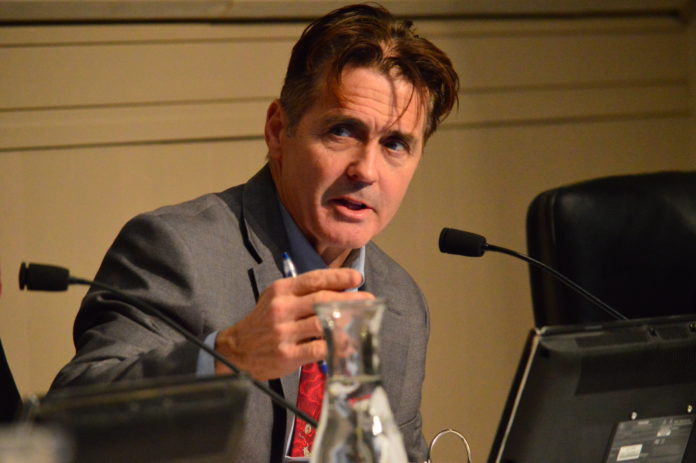The South Pasadena City Council on Wednesday approved the first reading of ordinances clarifying the roles of its two infrastructure commissions. The Freeway & Transportation Commission is being renamed the Mobility and Transportation Infrastructure Commission (MTIC) and the Public Works Commission (PWC)–formed in the wake of a controversy over the construction of the notorious “bulb-outs” on the sidewalk corners along Fair Oaks, and previously slated to disband–will be given permanent oversight of “non-transportation infrastructure” including water, sewer, stormwater, buildings and city facilities.
Approval came two months after the Council reviewed and sent back a plan to merge the commissions. That proposal came in the wake of the city’s perception that the commissions are subject to “overlap and friction” ill-suited to the need for new traffic management planning occasioned by both the final demise of the SR-710 freeway extension and the associated authorization for the city’s use of nearly $100 million in traffic and mobility funding over the next several years.
Both ordinances call for the commissions to serve as advisory bodies on policy to the city council “as directed by the city council or city manager.” After some discussion during the meeting, the Council agreed to remove that clause.
The change came in response to Third District Councilmember Richard Schneider’s request asking the Clerk to read a public comment submitted by Lawrence Abelson, who served as PWC vice chair through the end of December. Abelson argued the “as directed by” clause was redundant, confusing and “could have the effect of quashing one of the most important benefits of any commission, which is to provide ground-up ideas and support on matters within its purview…That cannot happen if the approach is ‘top down,’ where everything it discusses must first be approved by the city manager or city council.”
Abelson also said the ability to make recommendations on street capital improvements, previously in the purview of the PWC, was “noticeably absent” from either ordinance.
Kim Hughes, who served as the PWC chair through the end of last year, said she was glad there will still be two commissions. “They more eyes and residential community engagement will benefit everyone, including the Council.” But she said the ordinances do not seem to clarify which commission will address “the issue of looking at individual streets to repair” or which commission citizens should go to about specific street repairs.
City Manager Stephanie DeWolfe responded, saying the intent is that responsibility for streets and sidewalks would be with the purview of the MTIC. Fourth District Councilman Michael Cacciotti said, “That doesn’t sound right to me.” Curbs, gutters, sidewalks and streets ought to be before the PWC, he said.
Gayle Glauz, who also served on the PWC through last year, also wondered about the disposition of projects such as the annual street improvement plan and preventative maintenance, both large Public Works Department budget items that appear slated now to go to the Mobility Commission.
Fifth District Councilmember Diana Mahmud noted the City had revised its draft ordinance to expand the purview of the MTIC to clearly include its advisory capacity with respect to federal, state and local–not merely “regional” –transportation planning and funding. She said this change was sufficient to address the concern about MTIC’s purview over local streets.
DeWolfe agreed, adding that both ordinances “clearly mention” the capital improvement plan (CIP) with its street-related projects. “The street- and transportation-related portions of the CIP will go to the Mobility Commission and the non-street- and transportation-related portions of the CIP will go to the Public Works Commission.”
“Oversight is great, but I want to make sure that we have liability go where liability is accountable and reliable,” added Second District councilmember Marina Khubesrian. “We do need to have our professional staff apply due process to our capital improvement plans.”
In addition, she said, the public will now have a place to address comments on speeding, stop signs or whatever issue they have. “Hopefully they’ll now have a place that is designated to do that where before we didn’t.”
Schneider also said he too was glad there will be clarity. The role of the MTIC is it has authority over the streets. But “when it comes to implementation of construction management, that will be in the Public Works department.”
No one from the expiring Freeway & Transportation Commission spoke, though Joanne Nuckols, who served as FTC chair through the end of last year was present. She’d earlier told a reporter she did not think commissioners had been sufficiently consulted on the ordinances.
Just prior to Wednesday’s meeting, the city also clarified its intent concerning, and made some tweaks to, the ordinances staff had drafted. One was on how commissioners will be named. Under the ordinances, both commissions would consist of one member appointed by each of the five City Councilmembers. One would have a three-year term; two would have one-year terms but be eligible for another term of three years; and two would serve for two years and be eligible for an additional three-year term. After that, the mayor would appoint all members.
City Manager DeWolfe explained Wednesday that the initial term length appointment by councilmembers will “be determined by lottery.”
For both commissions, the city intends to recruit people with both relevant interest and professional experience, and to “make a concerted effort” to ensure there is at least one registered engineer with an active license on both bodies.
In this week’s tweaks, the city further refined the expertise it wants on the PWC to those with experience in structural engineering, architecture, landscape architecture, water, stormwater, sewers, and construction contracts, management or inspection.
The ordinance won’t take effect until 30 days after its second reading, probably at the Feb. 19 Council meeting. But the Council said it will go forward with recruiting members of the new commissions immediately.
These developments create an opportunity to envision and implement “a new mobility blueprint” for the city, a task that does not easily fall within the “narrow” purviews of the existing commissions, according to a city staff report.
Metro and Caltrans want the city to complete a feasibility study on specific projects including the SR 110 hook ramp at Fair Oaks. The city is also working on several major long-term planning efforts and a transportation grant application, and all of these “are interconnected and complement each other.”



















.png)











